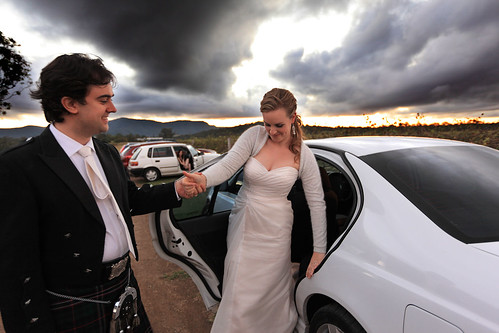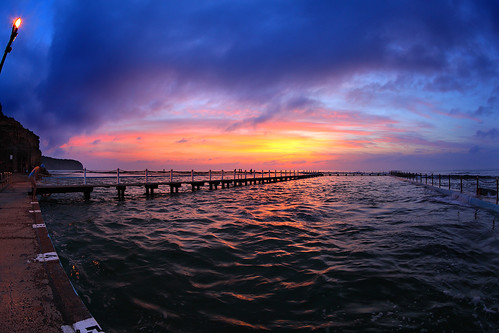We went to the Museum of Contemporary Art this afternoon on the recommendation of a friend to check out the 2010 Biennale of Sydney exhibitions there. The Biennale is one of the premier regular art exhibitions in the world, so it was a nice way to spend a warm winter day and soak up some culture. It was interesting, and I’d recommend anyone with the chance go see some of the Biennale exhibits while they’re still around (until 1 August). There are also exhibits at other venues, such as the Art Gallery of New South Wales, and on Cockatoo Island, for which there are free ferries departing regularly from Circular Quay.
There are two things I wanted to comment on, about art in general. Firstly, as seems to be moderately common in exhibitions of contemporary art, some of the artworks were quite provoking. Children were allowed into the exhibition, but a sign at the entrance stated that some of the artworks were provocative, including imagery of highly sexual and violent natures, and that accompanying adults should supervise and guide any children in their exposure to and understanding of the works.
Now one of my (many) working definitions that forms the complex and fluid entity of my understanding of what “art” is, is “something that provokes a reaction”. Under this definition, there were some things in the gallery that I’m perfectly happy to call “art”. My problem is that some of them were things that I didn’t enjoy seeing. They provoked a reaction of repulsion in me. And this led me to wonder: Is something that makes you feel repulsed and wish that you’d never seen it, art?
I prefer art that makes me feel good when I see it. I like art that shows workmanship and makes me admire the skill needed to achieve it. I like art that looks nice and is pretty. I like art that I’d be happy to display in my home. I like art that makes me look twice and think, “Hmm, that’s interesting,” or, “Hmm, that’s weird,” or even, “What on Earth is that?” But there was some art here that made me think, “Euughgh! Take it away!” I didn’t like it, and I didn’t want to spend enough time looking at it to appreciate the work that went into it.
So it certainly provoked a reaction. But is it the right sort of reaction that art should be trying to provoke? Or is it just something that some people might appreciate and that I didn’t care for? I find it extremely hard to say that it shouldn’t be there in an art exhibition. I’m just wondering what the artist was actually trying to do. I can see provoking a reaction of disgust when trying to get across a message that something is bad (such as one item which was a bunch of statues with classical Dutch portrait features, smothered in crude oil – obviously a message about industrial pollution). But is the goal of provoking revulsion, merely to provoke revulsion and for no other reason, a valid goal for art?
Again, I think I have to say that it is valid. I can’t sanction telling people that what they’re creating isn’t art just because I don’t like it. I think it does have what it takes to be “art”. But I can’t avoid the sneaking suspicion that that’s not what art is supposed to be about. There should be more to it than just making people feel disgusted. Perhaps in these cases there was, but it was hard for me to see it. And look, if there was, then no problem. But… what if there wasn’t?
The second thing I wanted to talk about was video installation art. We saw a very cool piece by German artist Christian Jankowski, titled Tableaux Vivant TV. I won’t describe what it’s about, because anyone planning to see it should just see it. But the problem was it’s about 30 minutes long, and we came in about 2 minutes from the end. That was sort of okay, since we didn’t have to wait long to see it from the beginning, but unfortunately it spoiled the ending a bit, and it’s an ending that would have benefited from being unknown at the beginning.
I noticed that several of the artworks at the exhibition are videos. This is natural and to be expected, since we live in an age where video is a common medium for both documentary and artistic expression. But the medium of video is fundamentally different to the traditional static art media, and that, as I see it, is a serious problem. Because a video has a certain running time. Ideally you’d want viewers to see a video from the beginning, and stay to the end. But in an exhibition, the videos are usually on loops, and it’s far too easy to walk into the display room partway through the video. This spoils the experience of the artwork.
There are some solutions. You can make a video for which it doesn’t really matter if you come in partway through, or only stay for a fraction of the entire running time. There were some videos like this in the exhibition, and they worked reasonably well. But there were also some videos that told a definite story and that would really be best seen from start to finish. Jankowski’s was one of these. One solution would be to put a running timer on the door to the exhibition room, showing when the loop will restart. But none of the videos included this helpful device, so people were constantly wandering in and out, seeing part of this half-hour video, and not really understanding what was going on or getting the point of it. This seems an awful waste.
The other thing about video installations like this is that they demand a certain block of your time and attention. Art in a traditional static medium can be examined at any time, at your leisure, for as long or as little as you want. You are not being forced by the medium of the artwork to interact with it in a temporally constrained way. This is a powerful advantage, because you can spend half an hour studying a painting, or you can whisk by absorbing impressions rapidly. You can’t do that with a video – if you give it a minute of attention, you can come away with nothing whatsoever but bewilderment and a feeling that you’ve wasted your time because you couldn’t spend long enough there to properly get it.
I don’t have any answers for this. I just wanted to point out that I think these are serious problems for video art, and apparently there still don’t seem to be any good solutions in general for them.



